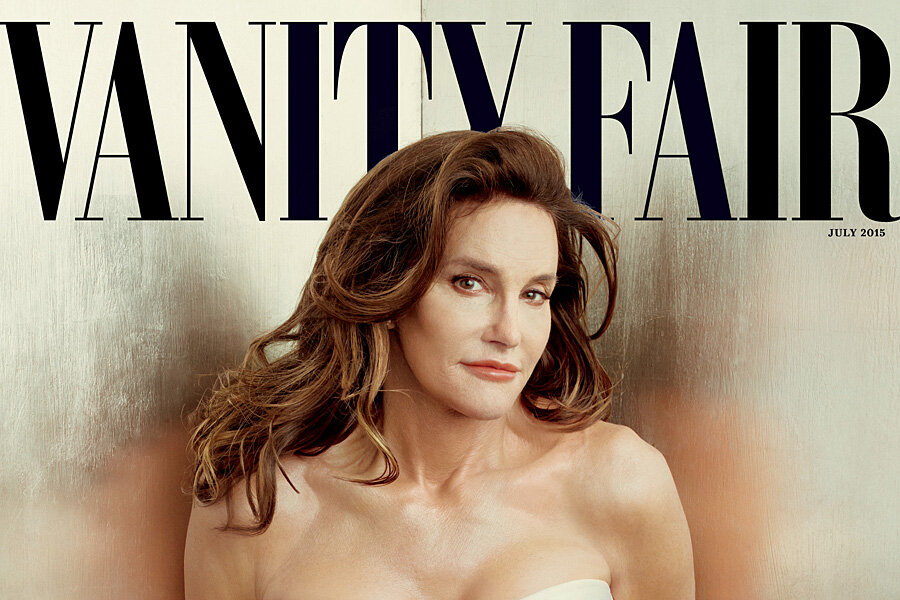America's Caitlyn Jenner moment: A tipping point for transgender acceptance?
Loading...
| Los Angeles
The handsome, muscular Bruce Jenner, whose picture appeared on the Wheaties cereal box the year after he won the Olympic decathlon gold medal, is on the cover of Vanity Fair this week, only now as Caitlyn Jenner, an attractive woman in a strapless, white corset.
Although not the first celebrity (think Chaz Bono) to transition from one gender to another in the public eye, Jenner lit up the cyber universe on Monday when she tweeted a photo of the Vanity Fair cover along with the declaration that at, age 65, she's finally "living my true self."
Twitter accounts, ranging from the one held by the White House to those of transgender advocates, sociologists and just regular folks, quickly retweeted the cover photo, most often with positive comments.
Even some poking lighthearted fun at the perfectly coiffed Jenner joked that the handsome former athlete looks even better as a woman in the perfectly posed picture by celebrated photographer Annie Leibovitz.
"All the women I know would LOVE to have the chance to have photos of themselves as beautiful as that one taken by Annie Leibovitz," said Eden Lane, an anchor and producer for Denver PBS television station KBDI and a transgender woman herself.
But more importantly, Lane added, is the positive impact Jenner's transition seems to have suddenly had on the transgender movement.
"When you know someone, it's easier to leave room in your heart and mind for them. To just be without fear of them or without hatred of them," she said.
And pretty much everyone, Lane added, feels they know Jenner.
Older people were enthralled by the amazing athlete who dominated one of the Olympics' most grueling competitions, the decathlon, in the 1976 Summer Olympics in Montreal. More recently, younger people have come to embrace the good-natured foil they saw on the long-running TV reality series "Keeping Up With the Kardashians." Until last December, Jenner was married for 23 years to Kris Kardashian and is the father of two of her children.
Her transition has played out in public over the past several months and included a high-profile interview with ABC's Diane Sawyer last April, in which Jenner, appearing nervous at first, declared, "Yes, for all intents and purposes, I am a woman."
The celebrity had no other choice but to do it that way, said veteran Hollywood publicist Howard Bragman, who represented Chaz Bono when the daughter of entertainers Sonny and Cher transitioned from female to male in 2009.
"The thing you have to understand about people like Caitlyn and Chaz is most people do this privately," said Bragman, founder and CEO of Fifteen Minutes Public Relations. "Public people don't get the luxury of doing that. It takes an extra amount of courage for them to do it, and to do it with class, and that's exactly what Caitlyn has done."
Not that it's necessarily easy, any way it's done.
"Even with the position Caitlyn is in and the positive reaction that seems to be surrounding her today, we can't forget that there are so many transgender people who don't have this environment, who are fearful just to step out of their homes or go to the grocery store or walk down the street every single day," Lane said.
Aside from violence, there's also the emotional toll. Jenner told Sawyer that she had contemplated suicide during the decades she struggled with her sexuality.
"To think she waited 65 years to come out if you will is a tragedy in itself," University of Southern California sociologist Julie Albright said. "Keeping a secret like that for so many years is bound to take a psychological and even a physical toll on you."
Renee Richards, the transgender pioneer who famously transitioned from man to woman in 1975, said recently that Jenner should benefit from living in a more enlightened time.
Richards was a successful doctor and, like Jenner, a father and star athlete.
But she had to sue to be allowed to play tennis at the U.S. Open, where she made it to the women's doubles finals in 1977. And she said doctors initially refused to help her when she approached them as a 40-year-old man.
"It was too scary for them," Richards recently told GQ Magazine. "They couldn't fathom how someone who had been so supremely successful in everything, in medicine, in sports, in life, as a heterosexual man, as a husband, as a father, they couldn't understand that.
"In this day and age," she added, "they would understand."
Copyright 2015 The Associated Press. All rights reserved. This material may not be published, broadcast, rewritten or redistributed.







